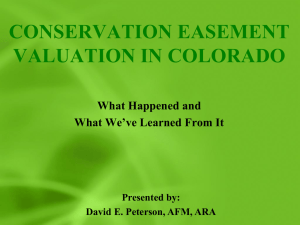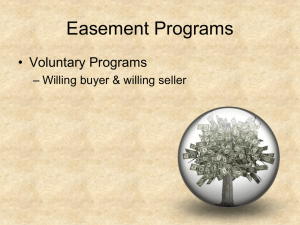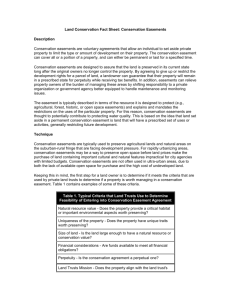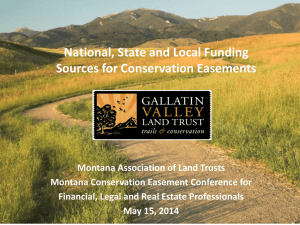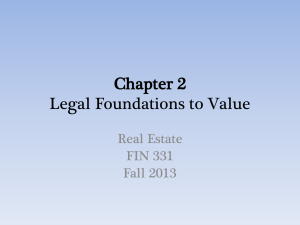Wielding conservation`s most powerful tool, Reid Rosenthal walks a
advertisement
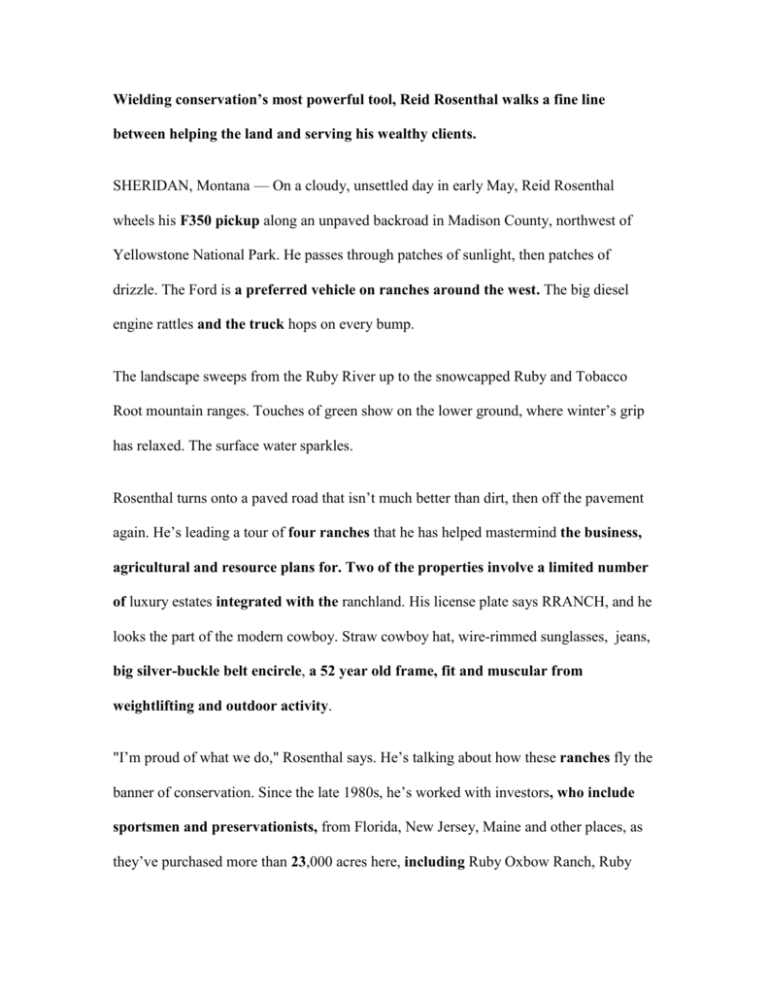
Wielding conservation’s most powerful tool, Reid Rosenthal walks a fine line between helping the land and serving his wealthy clients. SHERIDAN, Montana — On a cloudy, unsettled day in early May, Reid Rosenthal wheels his F350 pickup along an unpaved backroad in Madison County, northwest of Yellowstone National Park. He passes through patches of sunlight, then patches of drizzle. The Ford is a preferred vehicle on ranches around the west. The big diesel engine rattles and the truck hops on every bump. The landscape sweeps from the Ruby River up to the snowcapped Ruby and Tobacco Root mountain ranges. Touches of green show on the lower ground, where winter’s grip has relaxed. The surface water sparkles. Rosenthal turns onto a paved road that isn’t much better than dirt, then off the pavement again. He’s leading a tour of four ranches that he has helped mastermind the business, agricultural and resource plans for. Two of the properties involve a limited number of luxury estates integrated with the ranchland. His license plate says RRANCH, and he looks the part of the modern cowboy. Straw cowboy hat, wire-rimmed sunglasses, jeans, big silver-buckle belt encircle, a 52 year old frame, fit and muscular from weightlifting and outdoor activity. "I’m proud of what we do," Rosenthal says. He’s talking about how these ranches fly the banner of conservation. Since the late 1980s, he’s worked with investors, who include sportsmen and preservationists, from Florida, New Jersey, Maine and other places, as they’ve purchased more than 23,000 acres here, including Ruby Oxbow Ranch, Ruby Canyon Ranch, Ruby Canyon Overlook Ranch, Ruby Lake Ranch and Three Creeks Ranch; on each ranch, they make improvements to the land, agriculture, and resources. On several, such as Ruby Oxbow and Three Creeks, the final property disposition on those ranches, after a 5 to 15 year holding period, includes some limited smaller lots and are is finally in the form of independent working ranches ranging from 500 to 4000 acres. On others there is no residential construction, or just a single home. And they’ve made sure that development will be forever limited on about 10,000 acres of the land, by donating conservation easements to a nonprofit land trust. Rosenthal invested in some of the ranches himself beginning in mid 1999. His firm, Ranches of the West, Inc., typically serves as ranch manager. He says much of the land was "sadly degraded" by poorly managed cattle grazing and other past management practices, which afford opportunity for dramatic agricultural, aesthetic and resource improvement and attendant increases in value. He points out faint tracks in the grass, where ranch contractors have closed unnecessary roads; then to miles of fences they’ve modified to accommodate wildlife, protect large riparian areas around streams, and manage grazing; extensive irrigation systems for new hayfields; and new ponds for wildlife and cattle. He offers his binoculars for spotting dozens of elk, deer and antelope. The wildlife populations have increased dramatically, he says, and so has the production of hay and cattle. At Ruby Oxbow he also points out three substantial, earth-tone, wooden houses, built in the folds of the land. Two of the homesites are remodels or expansions of the old ranch headquarters. These houses are not "skylined" on ridgetops, which he considers insensitive, selfish and “visual pollution”. Instead, the view is mostly preserved. The conservation easements, he explains, have been an important component in the investors’ "business plans." He goes on to say that donating valuable property rights via the easements to the land trust, afford the owners of the Ranch tax breaks in the form of real cash tax savings, achieves preservation goals and allows an economic gain without having to resort to ranchette subdivisions. Similar weddings of conservation and business plans can be found throughout Madison County. One-fifth of the private land here is protected by conservation easements, a total of about 200,000 acres; the county may lead the West in that regard. Madison County remains rural, with only about 7,000 residents. But the landowners doing easement deals here include Atlanta-based billionaire Ted Turner; a billionaire Wal-Mart heiress and her husband, the owner of the Denver Nuggets; the CEO of the $100 billion AIM mutual funds; the founder of the $150 billion Oppenheimer mutual funds; the CEO of the Cox Enterprises multinational media empire; the family that built the Arm & Hammer Baking Soda conglomerate; a multimillionaire Silicon Valley entrepreneur; and the owners of several exclusive ski-resort developments. As in much of the scenic West, land conservation in the opinion of many here has become largely a rich man’s game. And many feel the conservation easement system serves upscale landowners to such a degree that a growing number of people think it’s unfair. Rosenthal has raised the hackles of some other Montanans, in fact, with his easement deals and other actions. "I’m controversial," he says, "because I represent the interests of my partners aggressively. I try to do what’s right, and what’s right for the land, and we don’t back down ... some people just don’t like that. That’s tough." Conservation developers, and others like Rosenthal who skirt the fine edge of limited development on some properties, and some who are even more aggressive, have drawn attention to what some people consider to be flaws in the easement system. Although easements have become the most popular tool for private-land conservation, keeping millions of acres from becoming dense subdivisions, there is arising a belief that the system is surprisingly loose, and easy to abuse. Certain members of Congress, conservationists, the Internal Revenue Service, certain academics and think tanks have jumped on board a movement to reform it. Proposals for improving the system range from gentle to drastic. But there’s a view that since conservation easements became popular 20 years ago, they’ve been enjoying a Wild West era. A look at the operations of the ranches managed by Rosenthal’s firm shows how the easement system works, for better or worse. "Don’t lose sight of the end goal: conservation of land. And there’s an economic equation to that." — Reid Rosenthal For the whole six-hour ranch tour, Rosenthal keeps himself going on a diet of unfiltered cigarettes, many cups of caffeinated coffee, and handfuls of chocolate drops. Rosenthal is preceded by three generations of family involved in land and cattle. He moved to Montana in the 1980s, around the time he resigned as Chief Executive Officer of several large Colorado development firms. The firms faltered after his departure and he was sued for his guarantee of certain loans made by lenders to his former companies. Those legal actions, which court records indicate he mostly won in the end, nevertheless forced him to file a rare personal Chapter 11 Business Reorganization. The Chapter 11, also according to Court records, listed about $1.9 million in unresolved debts. The Creditors voted unanimously for his Plan of Reorganization and the bankruptcy reorganization was resolved within 8 months of its filing. His move coincided with the beginning of the conservation-easement rush. Since the mid-1980s, the numbers of easements, acres protected by easements, and land trusts have soared. But each easement is merely a deal between two parties: the landowner, and either a land trust or a government agency that acquires the easement and monitors the land over time, making sure the terms are carried out. And every easement is unique, depending on the land’s condition, the local ecosystem, the landowner’s financial situation, and countless other variables. Landowners can design easements so they can keep on ranching, farming or logging. They can use herbicides and pesticides, sell lots, build houses, or create ski runs, as long as they don’t exceed the maximum development set out by the easement agreement. The IRS regulations merely sketch a list of conservation goals. Open space is the easiest goal, which explains why so many easements are dedicated to that. In addition to open space, the easements in which Rosenthal’s outfits have been involved generally include agriculture and resource goals. Landowners doing easements are typically motivated by their concern for the land, but as in any other business deal, they’re also interested in the bottom line. They may sell easements to an agency or a land trust, but it’s often difficult to find a buyer, because the budgets of land trusts and government agencies don’t stretch far. More often, the landowners donate property rights via the easement, affording them a financial return through tax breaks based on the appraised value of the donated rights. Some believe the tax breaks set off the easement rush: "Conservation easements are entirely a creature of the tax code," says Steve Small, a Boston lawyer who wrote the bedrock tax code on easements when he worked for the IRS in the early 1980s. The rules have been merely tuned a bit since then. The tax breaks are based on the claim that the owner has lowered the value of the land by voluntarily restricting its development, or donating other property rights. They include a reduction in the inheritance tax when the land passes to heirs, and in some states, a reduction in the annual property tax. Donated easements can also be claimed as charitable contributions on federal income tax returns. To maximize the income tax break, landowners can spread the deduction over six years. According to the IRS formula, the larger their income, the more quickly they benefit. Some persons feel the tax breaks make it easier for wealthy New Westerners to buy and hold land. "When all the smoke clears, they’ve bought (the land) for 60 percent of the selling price," says Lane Adamson, project A typical rural subdivision in Madison County. Ray Ring director of the Madison Valley Ranchlands Group, which coordinates local ranchers’ conservation efforts. Adamson thinks easement economics don’t work that well for the cash-poor, Old West ranch families struggling to hang onto their land. The inheritance-tax break helps some, but they often don’t have enough income to take full advantage of the income tax break. Working ranchers are just "hoping for a year with some black ink, instead of red ink," Adamson says. So they’re far less likely to put easements on their land. (Some innovations are aimed at making easements a better deal for ranchers.) Montana’s leading land trust sees the same pattern. Montana Land Reliance has been in business since 1978, specializing in donated easements. It now holds 593 easements covering more than 570,000 acres, and has a reputation for making deals with working ranchers — but only one-third of its easements are with that kind of rancher. The rest are with other owners including non ranching Montana families and New West landowners, about 50% of which are actually involved in agriculture, says Rock Ringling, a managing director for Montana Land Reliance. In today’s superheated market for ranch real estate, the easements can actually produce additional income for investors. Some believe that allowing landowners to grant easements in hot markets can double-dip the system, affording land-sales profits as well as tax breaks. Often "the ranch’s value actually increases," Adamson says, because of the uninterrupted views and other conservation amenities. "The larger the ranch, the more it’s worth per acre now. It’s just a matter of whose checkbook shows up." Rosenthal disagrees. “The donation of an easement adversely affects both the real and potential value of the land” he says. Regardless, conservation easement appraisals and section 170 of the Internal Revenue Code are clear that the enhancement factor, as it is called, certainly makes most property, if not encumbered by an easement, more valuable if adjacent to easement protected lands, and enhancement amounts must be subtracted from the donation value. Rosenthal and others have learned to use the potential of conservation easements to market real estate. For example, a sales pitch on one of his Web sites, www.ranchesofthewest.com seeking a buyer for 320 riverside acres, says, "The very significant tax benefits of a conservation easement are still available (hint, hint)." Rosenthal declines to discuss his partner’s tax breaks. The approximate 2,300-acre Three Creeks Ranch, a portion of which was originally planned for limited lot development, went through several phases of subdividing lots with the county planning office. Certain of those lots and more than twenty tracts existing prior to their purchasing the ranch in 1999, and immediately salable back then according to legal opinion of the State of Montana itself, were placed under easements, generating tax benefits worth more than $1 million, public records indicate. Now, most of that land is for sale as three or less big ranches of 400 to about 1,800 acres, for a total asking price of approximately $2.3 million. When developers go through a subdivision process, then donate easements on the lots, "in some cases, it seems like they’re just jacking up the value of their property, in order to turn around and get an income tax benefit, or to pass that benefit on to a future buyer, who might buy 10 lots only planning to build on one," says Madison County Planner Doris Fischer. "Part of the marketing strategy is to tell buyers, ’You can give up development rights on nine lots and get a wonderful tax deduction.’ “Of course subtracted from the tax deduction is the enhancement factor on the remaining lot. In addition to learning more about the ranch and its resources over the years, Rosenthal cites a different reason for scaling back the Three Creeks subdivision plans. He says a legal battle soured the whole project: Claims and counterclaims are flying between a Florida couple, including an attorney who worked for Ranches of the West and Three Creeks, who assert they bought two of the lots and Rosenthal and Three Creeks Ranch LLC. The lawsuit, which is still pending, has spawned a number of other ancillary actions, contains many arguments about land-management practices as well as counter claims by Three Creeks concerning the newcomers interference with Three Creeks water and ditch rights. It also alleges that Three Creeks improperly tried to put a conservation easement on the two lots after the sale. Three Creeks maintains the easement was granted, but the Florida couple blocked its recording after the grant, contrary to the Buy/Sell Agreement and deed. Rosenthal says he and Three Creeks acted properly, but admits he’s having a hard time making that particular easement stick, although easements cover most of the rest of the Three Creeks land. And it was a costly adjustment: The lawsuit indicates the Three Creeks investors would have gained another $160,000 in tax benefits from putting an easement on those 54 acres and have lost value to ranch lands to which the 54 acres is the only entry. Still, Rosenthal says, Three Creeks is preserving the landscape. As he drives around, he points to several lower-priced rural subdivisions popping up nearby. It is obvious he believes that to be the wrong approach. "If we hadn’t bought Three Creeks," Rosenthal says, "that’s what it would look like." "I’ve always had an adept feel for the energy of the land, what it’s going to take to make it right, to bring it back to signature status. ... I always get labeled a developer. It drives me crazy. I was a developer in another life, I know what a developer is. We are ranch operators and ranch preservationists." — Reid Rosenthal Rosenthal is definitely enthusiastic, believes in what he does, and speaks persuasively, but it’s difficult to weigh all the pros and cons of his conservation easements, or for that matter, of anyone else’s. The basic easement documents, describing which activities are allowed on each piece of land and which are tucked away in the files of the landowners, land trusts, and many other government offices. They are available for review at the county recorder offices. County and state agencies in Montana have computerized records and mapping, but no one has a complete list or map of all the Montana easements. The state’s Natural Resource Information System makes an effort to collect easement information from other government offices and land trusts. But the land trusts report only voluntarily, and the government records are so scattered, "My guess is that we probably have 90 to 95 percent of the (easement) acres, and maybe 75 percent of the number of easements," says Allan Cox, who runs the agency’s mapping program. The same goes in other states. And nationwide, the periodic surveys of land trusts by the Land Trust Alliance, a Washington, D.C.-based umbrella group, are similarly incomplete. The Alliance totals only the acres that the trusts choose to report, and hundreds of trusts don’t even respond to its surveys. The federal government doesn’t know how many acres of easements its agencies oversee, either. And the tax breaks are known only by the landowners, their accountants, the IRS, and sometimes, state revenue departments. The lack of what some believe should be public information, and of strict rules in the system, some believe has created an opportunity for abuse and led to calls for reform. "I’ve traveled around the country, meeting with land trust people in almost every state, and they are good people who want to do the right thing," says Small, a lawyer who now works on easement deals around the country. "Ninety-five percent of what’s been done (with conservation easements) has been from excellent to good, or medium good. Maybe 5 percent has been bad." Rosenthal probably fits in the "medium good" category. Unlike some landowners who are interested in simply preserving land, he employs easements on a small percentage of the ranches in which he is involved in conjunction with development. His projects also demonstrate how easements can serve investors, and how land trusts sometimes have to deal with landowners who may not be popular in their communities. For this story, Rosenthal provided letters from some traditional ranchers in the area, praising his work as a ranch manager and consultant. "Mr. Rosenthal was very aggressive on our behalf and negotiated superbly (with bankers). He saved us from litigation, bankruptcy, and from losing our ranch which we have owned for over 40 years," says one rancher’s letter. The Web sites of Rosenthal’s company also has quotes of praise from satisfied clients. On the other hand, Rosenthal is not a shrinking violet and, while he makes attempts to avoid court, is known to not have any qualms about legal battles if he believes his partners interests must be protected, and there is no other choice. In thousands of transactions, he, his businesses or partners, or his firm’s clients have been involved in approximately 30 actions in Montana courts, most of those actions related to, or stemming from, 4 or 5 core disputes over the 20 years he has been here, and mostly over the terms of various business deals or related to water, boundary or road issues. In their lawsuit, the couple from Florida who moved into Three Creeks complained that Rosenthal, on behalf of Three Creeks LLC, was harassing them with letters claiming they defaulted on their purchase agreement. Misdemeanor criminal charges of stalking and trespass were filed against Rosenthal including as elements of “stalking”, such matters as Rosenthal’s inspection of irrigation ditches involving Three Creeks water rights, and his ordering the removal of a lock the couple had placed on the parties joint pump system. After a trial in a local court, the jury found him not guilty of stalking. The trespass charge was thrown out, as were all similar charges against Three Creeks LLC contractor David White. The biggest complaint about Rosenthal, voiced by numerous Madison County residents as well as county and state officials, is their perception that his developments have shut down traditional public access. Grass grows tall on the banks The new perimeter fences, locked gates, no-trespassing of the Ruby River, the result of signs and “security guards” make it much harder for better management and anglers to reach the Ruby River, they say, and for easements, Rosenthal says. hunters or anyone else to set foot on the land. Ray Ring It’s a common complaint about many new owners of ranch properties around the West, and about conservation easements, which typically don’t allow for public access. But some people believe Rosenthal is in a special league. "He throws his weight around, scares people, he and his hired goons," says Tony Schoonen, a longtime fishing guide who runs the grassroots Public Land/Water Access Association, based in Butte. "He tells his buyers, the water is all private," despite a Montana law that guarantees public access to navigable waters. However, as the firm’s ads in the Madisonian over the past years, and practices indicate, Rosenthal’s firms do allow limited public access for fishing and hunting under strict controls, and generally to simply enjoy certain ranches so long as access is by foot or horseback. The Ranches of the West Inc., website does not use the term “private water” but rather the term “privately accessed water.”. An editorial on one of the Web sites by Rosenthal gives further insight into various parties positions on this volatile subject. Rosenthal’s determination showed in the course of setting up the Three Creeks easements. First Three Creeks LLC hired geologist Debbie Hanneman to evaluate whether mining might someday ruin the land. It’s a crucial step for "split estate" lands, where the mineral rights have been “severed”, a form of ownership change, after 1976. This corner of Madison County has been a historical hotspot for mining, and Three Creeks bears scars from failed old prospecting. Hanneman says she told Rosenthal it’s possible that it was economically feasible a mining company could someday dig into more than half the Three Creeks land, so no easements could be placed on that portion. "He came unglued," she says. Then Rosenthal hired another geologist, Hank Reed, who found little risk of future mining on Three Creeks. Rosenthal used Reed’s report for two of Three Creeks easements. Hanneman "only did a draft report," and the second geologist took a more thorough look, Rosenthal says. "It was like getting a second doctor’s opinion." A review of the resumes of Hanneman and Reed does indicate Mr. Reed has far broader, and longer range of experience with actual commercial extraction and commercial extraction economics. There are differing views, too of his firms’ management practices on some ranches. On part of the land they manage, he has restored patches of native sagebrush and encouraged vegetation on riverbanks, by managing the cattle more carefully than did the previous owners. Spring developments now feed watering tanks on miles of previously bone dry high desert bench. But, detractors, including Jim Deboer, a local game warden say, Rosenthal has cleared sagebrush, in their opinion, despite such acreage now being irrigated cropland, harming many species of birds, small mammals, and small plants that depend on sagebrush for cover. And Rosenthal’s plantings of alfalfa and crested wheatgrass (an exotic grass), a common practice by local ranchers, really benefit cattle more than wildlife, several experts say. There were elk camped out on the ridges above upland range improvements on Ruby Oxbow and Three Creeks the day of the tour. DeBoer also rejects Rosenthal’s claims that his land management has caused antelope, elk and deer populations to increase. The land improvements and water tanks have attracted the animals, but not increased their numbers, DeBoer says: "They’ve just been redistributed." However, Fish Wildlife and Parks records indicate that in the past two years, FWP, the agency employing Mr. Deboer, has begun issuing increased antlerless deer tags, and over- the- counter “either sex” tags for elk, in large hunting units 320 and 322 which include many of the ranches with which Rosenthal is involved. Such practice is usually an indication of increasing game populations. Montana Land Reliance has worked with Rosenthal on nine easement deals, totaling about 10,000 acres, but it did so reluctantly, says managing director Ringling. Ringling believes that new mining on the Three Creeks easements is flatly not economic, which is the test for remoteness and the public benefits outweighed the drawbacks on all the easements. If no land trust had accepted the easements, any future owner of the land could "slam houses along the riverbanks," Ringling says. “Did the Montana Land Reliance get conservation value at the end of the day? Yes. Can Reid Rosenthal be a royal pain in the ass to work with? Yes. Is he the worst? No.” Hanneman has been in the geology trade for about 20 years, and says that since her brush with Rosenthal, she won’t work on any more easements for gated developments. "I started running into (people) who wanted to do gated communities, do conservation easements, get their tax benefits, and then just lock it off. I got pretty fed up with that." "The buyers (who get the few houses in the ranch developments) come from everywhere. A lot of these folks, they’re not movie stars, but they’ve built up wealth over their careers, they have their retirement accounts, and very good equity in their properties in California, Florida, Texas, or wherever. They’re looking for a place to spend a portion of their time." — Reid Rosenthal The movement to reform the easements system might affect Rosenthal’s operations. His easement deals might have to place more emphasis on conservation goals, make more of the basic information publicly accessible, and possibly even guarantee public access to the land. Rosenthal says he thinks the system needs some tuning, to make it harder for scam artists, and transferable tax credits should be considered to assist local ranch and property owners, but he is leery of drastic reforms that might discourage many beneficial easements in the future. The “end goal has to remain the creation and maintenance of sustainable resources” he states. Rosenthal concludes the tour at one of his client’s newest ranches the Ruby Lake Ranch, in which Rosenthal also has a small personal interest. The ranch includes three miles of the shore of beautiful Ruby River Reservoir, which is formed by a dam in the river’s midsection From the shore, Ruby Lake Ranch rises up Garden Creek to a grazing lease for 2,000 acres of federal land, including portions of two wilderness-study areas. A cultural as well as economic struggle played out here. The Garden Creek Grazing Association, mostly old-time local ranchers who pooled their money 60 +/- years ago, owned about 17,500 acres including this land for many years and used it for summer pasture. The Ranch showed annual losses in the six figures each year. A partnership of conservation minded sportsmen bought a 32 percent interest in the association about 14 years ago, and began trying to improve the management, including range improvements, and gearing up long neglected irrigation areas, Rosenthal says. After ten years of trying to get along, frustration turned that effort turned into a lawsuit, pitting the new ranchers against the old ranchers who didn’t want to accept their advice, and even turning some ranchers against others. Masters were appointed by the Court and the masters representing the two sides made a unanimous decision as to who was to get what in 2004. Finally, in a settlement in May, the new ranchers won this 5,600-acre portion of the association’s total holdings. "The deed is being delivered today," Rosenthal says. He points out how this land, too, bears the scars of poor management by the previous owners. Too many dirt roads shoot off in too many directions. Cattle have grazed the grass nearly to bare ground in places. Generations of teenagers have partied beside a pond that’s fed by warm springs, and they’ve left lawn chairs, sleeping bags and trash. ATV ruts go right up the bed of the warm creek. Already Rosenthal’s group have begun to install their new fences and locked gates, although the public may still enjoy the springs by foot and horseback with written permission. As usual, they plan new pivot irrigation for hay pastures, excavation for new ponds, a lot of seeding and resting of the land. Hundreds of valuable lots, scores of them lake front or overlooking the lake, could be developed and sold here. Rosenthal, when questioned about the owner’s plans said, “we don’t know, other then the resource improvements, quite what we are doing yet, but if there is going to be any development, I doubt that future conservation easements would reserve more than four homesites in the area of the lake”. "A developer could rape it, pave it, and smile all the way to the bank," Rosenthal says, “which we are not doing, and which we don’t, and won’t do. I’m very much looking forward to this work here”. It’s going to be good stuff."

